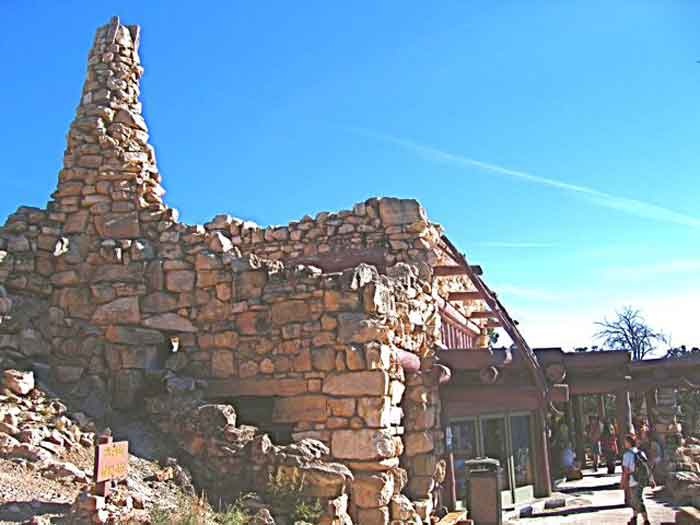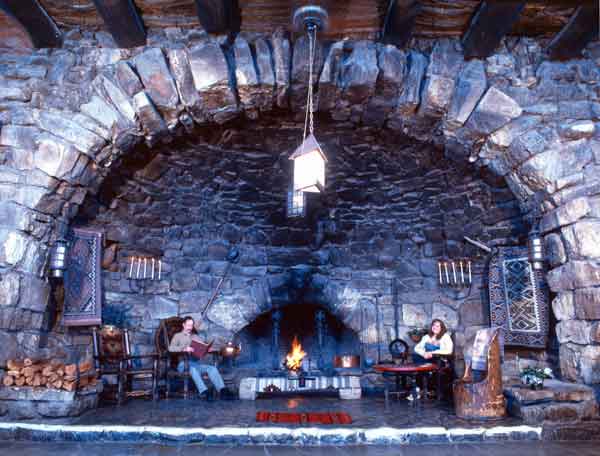At the western edge of the developed portion of the Grand Canyon’s South Rim visitors stumble across a small stone structure nestled back into a mound of earth opening into the canyon. Hermit’s Rest, which at first glance might appear to be a structure hastily erected by an early Euro-American settler at the canyon, is really a carefully constructed building commissioned by the Fred Harvey Company in 1914. For nearly 100 years it has provided shelter, food, and curios for tourists at the end of the West Rim Drive.
Designing Hermit’s Rest was architect Mary Jane Colter’s first job as a full-time employee of the Fred Harvey Company. The company wanted a rest stop at the end of the West Rim Drive where their horse-drawn carriages could deposit visitors and turn around, and where tourists embarking on the Hermit Trail or arriving at the rim from Hermit Camp could relax. The company considered many designs, including a small Swiss chalet mimicking the style used for its luxury hotel El Tovar.
However, Colter proposed a completely different style more American in origin. She developed a story behind the building—she wanted it to represent an abode that might have been built by an early Euro-American settler such as Louis Boucher, the “hermit” for whom many sites on the western portion of the South Rim was named. By developing a story behind her design, Colter helped tie both the building and its architecture into the local cultural landscape.
As with the other buildings she designed for Grand Canyon, Mary Colter designed Hermit’s Rest in what is known as “National Park Rustic” style. In this style, buildings are supposed to look as if they were built with old-fashioned hand tools and made of materials that at least appear to have been taken from the surrounding landscape. Whereas her first building at Grand Canyon, Hopi House, was inspired by ancient Native American traditions in the area, for Hermit’s Rest Colter drew upon the stories and architecture of Euro-American settlers. The resulting building reflected both the National Park rustic style and Colter’s concept of a hermit’s stone cabin.
The structure appears modest and organic from the outside, but once inside a massive stone interior wall with a large fireplace invariably surprises visitors, adding an element of grandeur to this otherwise simple structure–a faux hermit’s rest exuding peace and solitude built by a hospitality company to serve thousands of visitors.
The building is set back several feet from the rim. It was built into a man-made earthen hill to help it further blend into its surroundings. The roof features uneven parapets to make it look more haphazard. The pathway leading to the rest stop begins at a small stone arch with a bell at the top that Colter found at an old Spanish mission, though because of vandalism in recent years the path has been moved so that visitors can no longer walk through the archway.
The north side of the building, which faces the canyon, is made of rubble masonry laid with cement and log beams. The stonework makes the building look almost like it was carved out of a natural rock formation.
A porch made of peeled-log posts and wooden roof beams shelters the entrance and part of the curio store. From a small observation area, visitors can see the Hermit Rapids on the Colorado River, and many features in the Supai and Redwall formations.
Colter, known for her attention to details, made sure that the interior conveyed the atmosphere she was attempting to create as well. She helped rub soot on the stones of the enormous fireplace that covers the south wall to make it look well-used. In other words, Colter did not want Hermit’s Rest to look like a modern structure; she intended it to look as if it was so old that it was almost part of the historical cultural landscape, both inside and out. Other special touches she included that contribute to the historic tone are rustic chairs, a European pendulum clock, bear traps, and “pioneer” items decorating the posts.
The interior is divided into two large spaces. The main room features a soaring roof, nearly two stories high, that is flat with a wooden beam ceiling. Large windows let in streams of natural light that also contribute to the building’s ambiance.
The south wall consists of an enormous alcove with a huge arched fireplace, decorated with several antique kitchen and fireplace tools. The flagstone floor of the alcove is a step up from the rest of the room, giving added emphasis to this feature. The other major space inside the building, to the east, is a curio shop with a smaller stone fireplace. Though only accessible from the outside, the western portion of the building consists of a snack bar.
The Fred Harvey Company opened Hermit’s Rest in 1914. The road from Grand Canyon Village to Hermit’s Rest was the only paved road in the park, and was resurfaced in 1920, making it one of the more comfortable scenic drives and popular stopping points at the Grand Canyon. The Fred Harvey Company provided sightseeing tours in cars and buses along this route, and Hermit’s Rest was the starting point for mule trains down to its Hermit Camp facility in the inner canyon.
Hermit’s Rest closed during most of World War II. It reopened in April 1946, at the same time that scenic tours along the West Rim Drive resumed. In the early 1950s the National Park Service constructed a modern restroom facility at the site for the comfort of visitors. In the 1970s, the NPS stationed a ranger at Hermit’s Rest to help register hikers along the Hermit Trail. Today, the building still provides a place for travelers to rest, purchase souvenirs, and marvel at Mary Colter’s unique architectural vision that combines features of the local culture and environment.
Written By Sarah Bohl Gerke and Paul Hirt
References:
- Anderson, Michael F. Polishing the Jewel: An Administrative History of Grand Canyon National Park. GCA, 2000.
- Anderson, Michael F. Along the Rim: A Guide to Grand Canyon’s South Rim from Hermit’s Rest to Desert View. GCA, 2001.
- Anderson, Michael, ed. A Gathering of Grand Canyon Historians. Proceedings of the Inaugural Grand Canyon History Symposium, January 2002. GCA, 2005.
- Grattan, Virginia L. Mary Colter: Builder Upon the Red Earth. Grand Canyon Natural History Association, 1992.
- Harrison, Laura Soulliere. Architecture in the Parks: Excerpts from a National Landmark Theme Study. National Park Service, Department of the Interior, 1986.





